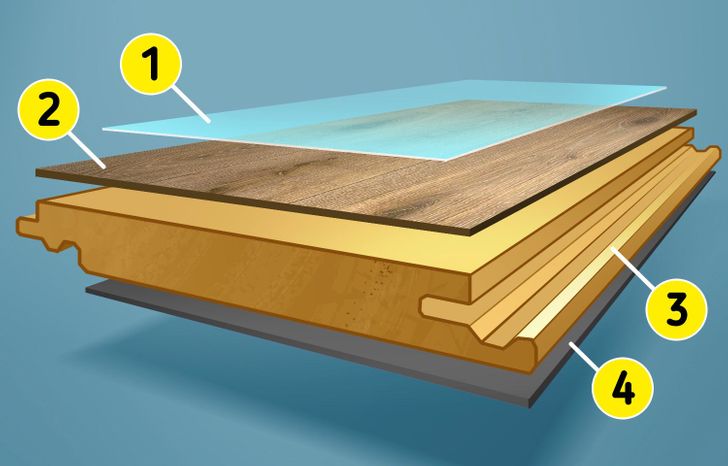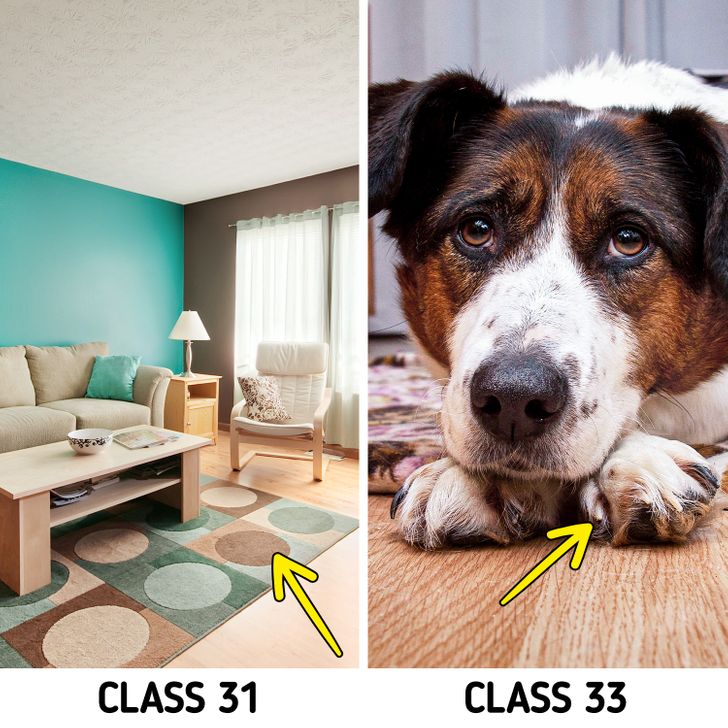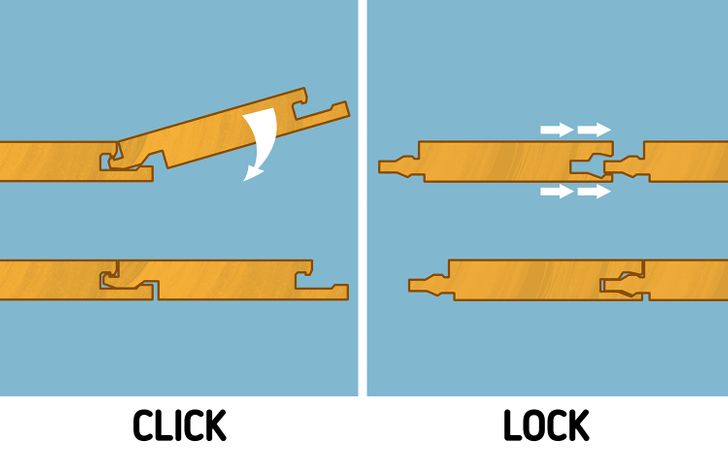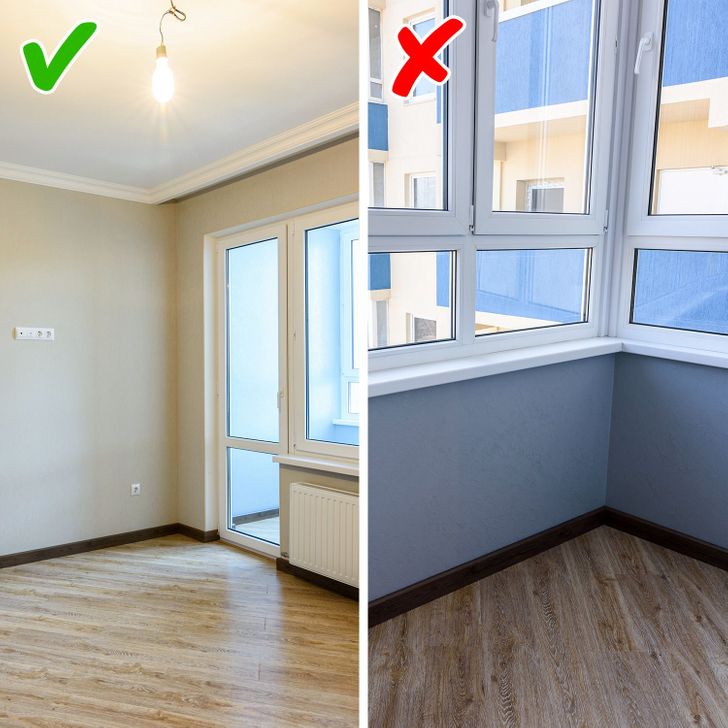How to Choose Laminate Flooring
Laminate is a pretty new and affordable material that makes the floor look beautiful. Previously, it was chosen to save money during repairs. Today, it is able to compete not only with parquet flooring, but even with ceramic tiles in terms of its qualities.
We at 5-Minute Crafts gathered several useful recommendations and advice that can help you choose good-quality laminate flooring.
What is laminate flooring
Laminate is a multilayered cover for the floor. Its base is made of chipboard or fiberboard. On top, it has a decorative paper layer that imitates natural wood. We could say that it is a modern alternative to parquet: laminate is simpler to install, and cheaper and easier to take care of.

Most laminate boards consist of 4 layers:
-
The upper layer protects it from abrasion and tear. Sometimes the upper layer of laminate has an unevenness that imitates the texture of natural materials.
-
The decorative layer is responsible for the appearance of the laminate: basically, it’s paper that has the wood, stone, tile, or other textured pattern printed on it.
-
The core layer consists of a chipboard or fiberboard. Its thickness fluctuates between 6 mm and 12 mm. This layer has the lock for connecting laminate boards with each other.
-
The bottom layer protects the board from deformation, stabilizes it, and enhances its firmness.
What you should pay attention to when choosing laminate flooring

- Wear class
This parameter is determined by the thickness of the laminate. The laminate is classified according to the level of wear. There are many factors that are checked and taken into account during this classification. It’s the strength of the protective coating, resistance to indentation, reaction to aggressive chemicals, resistance to flammability, and moisture resistance.
Today, the market mostly offers laminated boards from class 31 to class 34. The class least resistant to wear is 31. It is suitable for areas with light use like bedrooms or studies. It would be better to opt for class 32 for a sitting room and class 33 for a hallway, or any other room if there is a dog in your house. On the other hand, class 31 can be suitable for the living room as well, but you’d need to lay a carpet next to the sofa and armchairs.
- The material of the board
Good quality laminate is made on the basis of high-density fiberboard (HDF). If MDF or hardboard is taken for the base instead of HDF, then the lifespan of the laminate will be reduced, and the price will be lower.
- Eco-friendliness
Formaldehyde is used when producing laminate flooring. An E1 marking means that despite its presence in the composition, the laminate is eco-safe. If there is no such marking on the product and the laminate has an unpleasant smell, you’re better off not buying it.
- The thickness of the board
Many people believe that the main disadvantage of laminate flooring is its thinness. That’s why unlike parquet, it doesn’t absorb noise and doesn’t retain warmth. But the thickness of the board can be different and reach up to 12 mm. Moreover, there are beautiful and expensive types of laminate flooring that visually can’t be distinguished from parquet and even exceed parquet in some properties. For example, it is unfazed by pets claws and spilled water.

-
The type of connections for laminate boards
If planks are knocked into each other, it’s a lock type of click together installation. If the elements are connected with the help of locks, it’s called a click. This type of installation is more convenient and more expensive.
In the first case, you’ll need to lift the entire row of installed laminate flooring to connect it with a new plank that is fixed on only one side (its length); after that, the planks are connected to each other. There is also a type of click together installation where the element is connected with a plastic insert in its side (width) part. In this case, you won’t have to lift the entire row of laminate flooring.
Click elements are fixed on one side (length), after which it’s necessary to adjust their width part. Though it can be more convenient, it’s easy to break the click elements.
- Resistance to scratches
This parameter depends on the protective layer of the board and is not related to the class. It is usually denoted by the letters AC and numbers ranging from 1 to 5. The larger the number, the more abrasion resistant the board is.
- Manufacturing technology
The simplest option to make laminate flooring is by pressing all layers under the influence of high temperatures. This type of manufacturing is denoted as DPL. Nowadays there are more modern technologies, thanks to which the life of using the laminate flooring is extended — this material has an HPL or CPL marking.
- Laminate standards and manufacturers association
If a laminate manufacturer is a member of the European Producers of Laminate Flooring (EPLF), it means its material is definitely high quality, and all properties declared on the packaging are confirmed. Another indicator of high quality can be product compliance with EN13329 standards.
How to choose the correct laminate flooring according to the room

-
If you like to walk around the house in hard-soled shoes or even small heels, then it is better to opt for class 32 laminate flooring even for the rooms that you rarely use.
-
Don’t go for laminate flooring in Florida rooms or glassed-in balconies. There are other materials that are more resistant to temperature changes and humidity, like vinyl flooring that also imitates wooden surfaces.
-
If you are laying the laminate flooring by yourself for the first time, it’s better to pay a bit more and buy the one that is easier to install rather than have to re-install it later.
-
It’s recommended to choose waterproof laminate flooring for the kitchen and eco-friendly and hypoallergic materials for a kid’s room. For example, you can use cork as an underlayment.
-
Cold shades of light colors can help to broaden the room visually, while warm shades will bring a certain coziness to your space. In order not to be mistaken about your choice, take a sample of the flooring home and see how it will combine with the other materials in the room as well as whether its appearance will change depending on the lighting.
-
The thicker the laminate boards are, the warmer your floor will be. On the other hand, thinner boards are better combined with a system called “warm flooring.”
Frequent mistakes
-
A consistent room temperature is among the factors that are important for laminate flooring. Small fluctuations in humidity are allowed. This means that this flooring should not be used in a country house that is not heated in cold weather.
-
Moisture-resistant boards are treated with a compound that protects them from moisture, but only for a little while. This laminate flooring will withstand wet cleaning, but if you spill water on it and don’t wipe it up, the board will become thicker and the floor will become uneven. Still, there is a waterproof laminate that can be used in the kitchen or even in the bathroom, because it is not affected by water.
-
Don’t be stingy about the underlayment. It evens the floor, provides additional heat and soundproofing, as well as generally extends the life of laminate flooring by several years. It is better to give preference to natural materials like cork or pine.